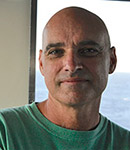Expedition 15:
Jan. 2 - 22, 2014
|
An Underwater WorldJanuary 16, 2014 (posted January 17, 2014) Watching the live video feed in Jason’s control van feels a bit like taking a safari on another planet. Bizarre creatures at the vents below us move slowly across the screens: ghostly octopi, bleached-white crabs, tubeworms as big as your arm. It’s the kind of image you can lose yourself in for hours. I often do. This is a world that few people have seen. It’s a mile and a half under water, pitch black, and nearly inaccessible to humans (without the use of sophisticated submarines or robotic vehicles, that is). Fortunately, Jason can reach those depths without a problem, and it took plenty of cameras with it for the ride. In these videos, take a deep-sea safari of your own, and see footage of some of the amazing sights we’ve encountered on the ocean floor. In this video, Jason hovers near a towering vent site called “Bio9.” The tall, elegant structures you see here may look rock solid, but they’re actually incredibly fragile. The towers are made up of a loose collection of minerals that build up as vent fluid flows out of the seafloor and interacts with cold seawater. Their loose consistency makes them very difficult to sample, as you can see in this video from Monday. Not all vents are high-temperature “black smokers” like the ones shown in the video above. Some, like Crab Spa, shown here, are cooler and more slow-flowing. These types of vents form as cold seawater seeps below the ocean floor and mixes with the ultra-hot fluids that feed the vent. The seawater cools the fluids before they emerge from the rocks. Most large animals that live at vent sites seek out this sort of flow, because this is also where most of the chemosynthetic microbes live. The fluid coming out of a black smoker is too hot for life, but the water here is at a good temperature for living things, and full of the chemical nutrients that sustain the organisms in the ecosystem. In this video, an oxygen sensor is placed into the mouth of Crab Spa amid a thicket of tubeworms and mussels. As a crab fights with the sensor, a Zoarcid fish floats by to survey the scene. Later in the clip, you’ll see another view of the vent after researchers removed the animals living there. These animals can change the chemistry of the vent site, so the scientists stripped them off for study and to gain access to the vent’s mouth with Jeff Seewald’s Isobaric Gas-Tight sampler. The white flecks coming out of the vent are actually a mix of sulfur and bacteria. The sulfur is created by some bacteria as they "eat” hydrogen sulfide, a chemical commonly found in vent fluid. Researchers stumbled across this ghostly white octopus while exploring a section of the seafloor between vent sites. Although these animals are among the top predators at vent systems, this one doesn’t seem very interested in the red shrimp it floats past. These long, thin worms are commonly known as “spaghetti worms.” Hundreds of them lie among rocky outcroppings on the seafloor near certain deep-sea vent sites. As they drape themselves across the rocks, they may filter nutrients out of the water but according to marine biologist Horst Felbeck, not much is yet known about them. “They tend to disintegrate when you try to pick them up, which makes studying them kind of difficult,” he said. This site, which researchers discovered just a few days ago, is nicknamed “Teddy Bear” because of the hairy-looking mats that coat the rocks nearby. Although researchers are fairly certain that these “hairs” are actually thin strands of bacteria, they don’t yet know which bacteria they may be. The scientists were able to collect samples, though, and will analyze them back on shore.
Get to know the crew
Lance Wills, able-bodied seaman on the Atlantis, has spent 30 years working on ships of all sorts, from fishing boats to research vessels. Over the years, he’s picked up plenty of good stories. He also picked up photography skills and a master’s degree in journalism. When he’s not standing watch on the bridge, Wills is often writing in his cabin and has penned several books here on the ship. Read the interview » [ Previous update ] [ Next update ]
|
Mailing List | Feedback | Glossary | For Teachers | About Us | Contact
© 2013 Dive and Discover™. Dive and Discover™ is a registered trademark of Woods
Hole Oceanographic Institution



